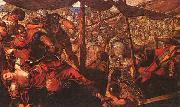Wholesale Oil Painting No Minimum |
|||||||||||
|
|
|||||||||||

|
|||||||||||
|
|
|
||||||||
Jacopo Robusti Tintoretto1518-1594 Italian Tintoretto Galleries The real name of Tintoretto was Jacopo Robusti, but he is better known by his nickname, meaning the "little dyer, " his father having been a silk dyer. The artist was born in Venice and lived there all his life. Even though his painting is distinguished by great daring, he seems to have led a rather retired life, concerned only with his work and the well-being of his family. His daughter Marietta and his sons Domenico and Marco also became painters, and Domenico eventually took over the direction of Tintoretto's large workshop, turning out reliable but un-inspired pictures in the manner of his father. Some of them are, on occasion, mistaken for works of the elder Tintoretto. Tintoretto appears to have studied with Bonifazio Veronese or Paris Bordone, but his true master, as of all the great Venetian painters in his succession, was Titian. Tintoretto's work by no means merely reflects the manner of Titian. Instead he builds on Titian's art and brings into play an imagination so fiery and quick that he creates an effect of restlessness which is quite opposed to the staid and majestic certainty of Titian's statements. If Tintoretto's pictures at first sight often astonish by their melodrama, they almost inevitably reveal, at closer observation, a focal point celebrating the wonders of silence and peace. The sensation of this ultimate gentleness, after the first riotous impact, is particularly touching and in essence not different from what we find (although brought about by very different means) in the pictures of Titian and Paolo Veronese. Tintoretto was primarily a figure painter and delighted in showing his figures in daring foreshortening and expansive poses. His master in this aspect of his art was Michelangelo. Tintoretto is supposed to have inscribed on the wall of his studio the motto: "The drawing of Michelangelo and the color of Titian." Unlike Michelangelo, however, Tintoretto worked and drew very quickly, using only lights and shadows in the modeling of his forms, so that his figures look as if they had gained their plasticity by a kind of magic. In the rendering of large compositions he is reported to have used as models small figures which he made of wax and placed or hung in boxes so cleverly illuminated that the conditions of light and shade in the picture he was painting would be the same as those in the room in which it was to be hung. |
||||||||
|
|
||||||||
Battle
Battle Painting ID:: 1645 |
|
|||||||
|
|
||||||||
|
Jacques Courtois (also called 'il Borgognone' or Giacomo Borgognone) (1621 - 20 May 1676?) was a French painter. He was born at Saint-Hippolyte, near Besançon. His father was a painter, and with him Jacques remained studying up to the age of fifteen. Towards 1637 he went to Italy, was received at Milan by a Burgundian gentleman, and entered, and for three years remained in the French military service. The sight of some battle-pictures revived his taste for fine art. He went to Bologna, and studied under the friendly tutelage of Guido Reni; thence he proceeded to Rome, where he painted, in the Cistercian monastery, the "Miracle of the Loaves." Here he took a house and after a while entered upon his own characteristic style of art, that of battle-painting, in which he has been accounted to excel all other old masters; his merits were cordially recognized by the celebrated Cerquozzi, named Michelangelo delle Battaglie. He soon rose from penury to ease, and married a painter's daughter, Maria Vagini; she died after seven years of wedded life. Prince Matthias of Tuscany employed Courtois on some striking works in his villa, Lappeggio, representing with much historical accuracy the princes military exploits. In Venice also the artist executed for the senator Sagredo some remarkable battle-pieces. In Florence he entered the Society of Jesus, taking the habit in Rome in 1655; it was calumniously rumoured that he adopted this course in order to escape punishment for having poisoned his wife. As a Jesuit Brother, Courtois painted many works in churches and monasteries of the society. He lived piously in Rome, and died there of apoplexy on 20 May 1676 (some accounts say 1670 or 1671). His battle-pieces have movement and fire, warm colouring (now too often blackened), and great command of the brush, those of moderate dimensions are the more esteemed. They are slight in execution, and tell out best from a distance. Courtois etched, with skill twelve battle-subjects of his own composition. The Danzig painter called Pandolfo Reschi in Italy was his pupil. His brother Guillaume was also a painter in Italy. Battle between 1650(1650) and 1660(1660) Medium oil on canvas Dimensions Height: 114 cm (44.9 in). Width: 170 cm (66.9 in). cjr |
||||||||
|
|
||||||||
|
Prev Next
|
||||||||
|
|
||||||||
|
Related Paintings to Jacques Courtois :. |
||||||||
|
|
||||||||
|
CONTACT US |

